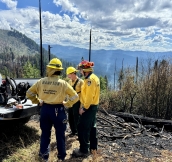Friction loss is the resulting resistance as water (fluid) moves along the inside wall of either a hose, pipe, or hose fittings.
Points to remember about friction loss:
- Friction loss increases as flow (gpm) increases.
- Total friction loss varies with length -- the greater the length, the higher the friction loss.
- Friction losses on reeled hose average about 21 percent more than for straight hose lays.
- Friction loss is nearly independent of pressure.
- Friction loss varies with type, lining, weave, quality, and age of the hose.
- Friction loss increases 4 times for each doubling of water flow. Reducing the diameter of a hose by 1/2 will increase the friction loss by a factor of 32 for the same flow.
To account for friction loss, the pressure at which the pump is working must be increased. The pump pressure must also be or decreased to compensate for the head loss or gain, to produce the desired nozzle pressure.





